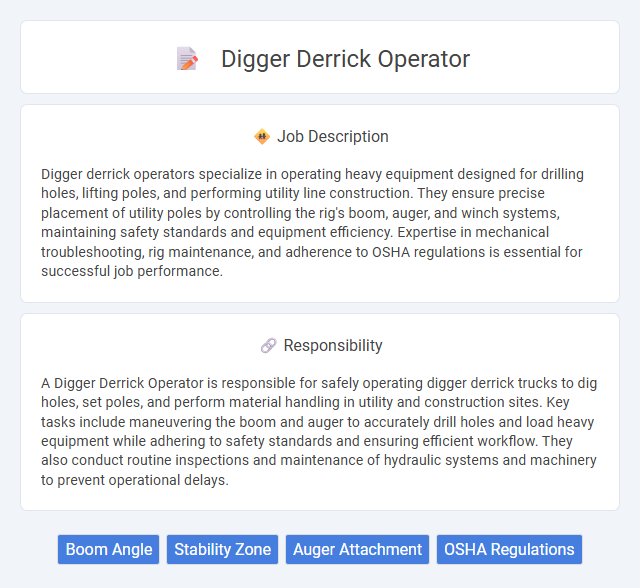
Digger derrick operators specialize in operating heavy equipment designed for drilling holes, lifting poles, and performing utility line construction. They ensure precise placement of utility poles by controlling the rig's boom, auger, and winch systems, maintaining safety standards and equipment efficiency. Expertise in mechanical troubleshooting, rig maintenance, and adherence to OSHA regulations is essential for successful job performance.
Individuals with strong physical stamina and good hand-eye coordination are more likely to be suitable for a digger derrick operator job due to the demanding nature of operating heavy machinery. Those who can maintain focus under pressure and adapt to varying weather conditions probably have a higher chance of excelling in this role. Conversely, people with limited physical endurance or difficulties in spatial awareness may find this occupation challenging.
Qualification
A Digger Derrick Operator must possess specialized training in operating heavy equipment, specifically digger derricks used for drilling and lifting in utility and construction projects. Essential qualifications include a commercial driver's license (CDL), extensive knowledge of safety protocols, and the ability to read and interpret technical diagrams. Proficiency in mechanical maintenance and strong physical stamina are critical for efficient and safe operation.
Responsibility
A Digger Derrick Operator is responsible for safely operating digger derrick trucks to dig holes, set poles, and perform material handling in utility and construction sites. Key tasks include maneuvering the boom and auger to accurately drill holes and load heavy equipment while adhering to safety standards and ensuring efficient workflow. They also conduct routine inspections and maintenance of hydraulic systems and machinery to prevent operational delays.
Benefit
A digger derrick operator likely benefits from competitive wages and opportunities for overtime pay due to the specialized nature of the work. The job may offer comprehensive health insurance, retirement plans, and paid time off, enhancing overall employee well-being. Safety training and career advancement possibilities could also be significant advantages in this role.
Challenge
Operating a digger derrick likely presents significant challenges due to the precision required when handling heavy equipment near power lines or confined spaces. The complexity of coordinating machinery movements with safety protocols may increase the probability of unexpected obstacles or mechanical issues. Mastery of this role probably demands constant vigilance and adaptability to rapidly changing worksite conditions.
Career Advancement
Digger derrick operators can advance their careers by gaining experience with complex equipment and obtaining specialized certifications such as OSHA or NCCCO. Mastery of advanced rigging techniques and leadership skills often leads to supervisory or training roles within construction and utility companies. Continuous professional development and safety training enhance job prospects and salary potential in this high-demand field.
Key Terms
Boom Angle
A Digger Derrick Operator must precisely control the boom angle to ensure safe and efficient lifting and digging operations. Optimal boom angle management enhances load stability and maximizes reach, critical for utility pole installation and maintenance tasks. Consistent monitoring and adjustment of the boom angle reduce the risk of equipment damage and improve operational safety.
Stability Zone
A Digger Derrick Operator is responsible for maintaining the stability zone while operating heavy equipment used in lifting and setting utility poles. Ensuring the stability zone involves precise placement of outriggers and continuous monitoring of ground conditions to prevent equipment tipping or collapse. Mastery of these safety protocols is essential to uphold operational efficiency and prevent accidents during excavation and construction tasks.
Auger Attachment
A Digger Derrick Operator specializes in controlling the digger derrick machinery equipped with an auger attachment to efficiently drill holes for utility poles and foundations. Mastery of the auger attachment enhances precision and speed, reducing operational downtime and improving project timelines. Proficiency in safely maneuvering the auger attachment is critical for preventing equipment damage and ensuring worker safety on construction or utility sites.
OSHA Regulations
Digger derrick operators must comply with OSHA regulations outlined in 29 CFR 1926 Subpart CC, which covers cranes and derricks in construction. Operators are required to undergo thorough training and certification to ensure safe handling of equipment, minimizing the risk of accidents such as tip-overs or electrocution. OSHA mandates regular equipment inspections and adherence to load limits, promoting workplace safety and regulatory compliance for digger derrick operations.
 kuljobs.com
kuljobs.com